What is Tenkara Fishing?
This simple question can have the very simple answer of “Traditional Japanese fly fishing”. It was developed for catching trout and char in mountain streams so that villagers with little or no money could survive. Originally, it was not a trivial sport. It was a matter of life and death.
Now it has changed into a way you can find both relaxation and excitement – but as you’ll see when you scroll down this page; there is a lot more to it than meets the eye…A phrase coined by Daniel Galhardo of the company Tenkara USA suggests it is just “rod, line & fly” – which hints at the lack of reel and the pared-down minimalism of the gear. It is incredibly elegant when done well.
Although surprising to many – the genuine fly-casting “loop” is at the core of that elegance, delicacy and enjoyment in tenkara.
But any short answer ignores a mountain of fascinating detail relating to the culture, techniques and history of tenkara. The information overload can be very confusing and it’s difficult to get tried and tested information. Instead it is MUCH easier to find bad information and poor advice about tenkara on the internet…and many people even think that it is simply “dapping” or dangling a fly vertically from an outstretched rod…
That – and a ton of other myths and misconceptions – can put off people who would actually enjoy tenkara if they only had a proper introduction to the sport. What you really need is an accurate, clear and detailed explanation what tenkara really is… and this page is the first step.
Here’s what I’m going to show you on this page so you get a proper introduction:
- Tenkara rods (traditional and modern)
- Tenkara flies (most of them do NOT have reverse hackles in Japan)
- Tenkara fishing (core techniques that set it apart from regular fly fishing)
- Tenkara nets (known as “tamo” and only a recent addition to tenkara)
- Tenkara history (ancient, modern and its jump out of Japan to the west)
- Tenkara the word (known origins, myths & how Yuzo Sebata – aka “Sebata-san” – helped coin the word!)
In fact, let’s start with the word itself. Although there are a lot of stories, there is often a shortage of facts. On top of that, because so much of the historic culture of tenkara belongs to peoples who did not write things down, there is a natural limit to how far back you can look. BUT, this is very, very different from saying “we don’t know anything”. The neat thing is that, what we do know, really helps to tell the story of tenkara too.
Tenkara (テンカラ or てんから in older publications)
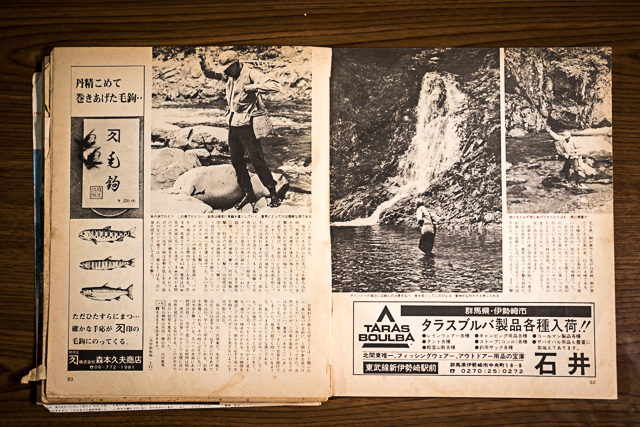
The word does not have a “kanji” (Chinese pictogram) in Japanese. It is simply spelled out the way it sounds. In fact, older publications – particularly magazines – would use either the katakana or hiragana Japanese “alphabets” to spell out the sounds. It’s interesting that katakana is the standard character-set used for Tenkara or “テンカラ” now because this is the system most often used for things in the natural
world like plants, animals and minerals or – alternatively – newer “loan words” from other dialects and languages.
Hiragana (e.g. てんから) can also be used to spell out every sound in the Japanese language and one of its uses is to spell out Japanese words where there are either no suitable kanji – or where the writer doesn’t know the kanji!
Because both alphabets were used to write “tenkara” in the past, it suggests that it was readily accepted as a Japanese word. The puzzling thing is that, without a pictogram, the meaning of the syllables depends on you knowing or guessing that meaning! Japanese only has a relatively small number of sounds – so those small number of sounds are often re-used and re-combined in different ways. The sound “kara” can mean “empty”, “after”, “from”, “because” and probably other things that I’ve never heard of.
Because a sound can refer to or be part of many different kanji – and even worse, one kanji can have many different sounds – translation is hard. In other words, it is NOT safe to say that one particular literal translation of the sounds “ten” (heavens) and “kara” (from) to give
“from the heavens” or “from the sky” is valid.
In the same way, the idea that “tenbin karabari” style fishing could be shortened to make “tenkara” also seems to be a nice theory. Unfortunately there isn’t any direct evidence to support that idea. Karabari means “empty hook” and the rig used a treble hook with a weight on which resembled the Japanese carrying pole/scales called “tenbin” – but that method has nothing to connect it to tenkara (instead it was a way of foul-hooking salmon).
Tenkara History
There is, though, at least one much more complete account of how the word “tenkara” was used to directly refer to exactly the style of fishing we now recognise…and we’ve been lucky enough to speak to two people who have had direct experience of different parts of that story (Yamada-san and Sebata-san). This is where the story of the word joins up with the history.
The Matagi Connection
Miwa Satoshi was kind enough to write out the account that he’d researched and also spoken about on the tenkara-fisher forums (given in full here). In it he describes how loggers in the Tōhoku region of Japan used the words tegara, tenkara, tengura, tenkarako, or tenkako to describe flying insects. Those same tree-felling/woodworking clans (known as kijiya or kijishi) would, therefore, naturally refer to “fly fishing” as “tenkara-tsuri”.
According to Wikipedia, the Kijiya are said to originate from a single village, Higashi-Ogura, in Kanzaki District, Shiga Prefecture. As migrant minority groups they moved about in groups of a few families, collecting wood in the mountains (they needed special permission from the Emperor to do this – since all trees and animals belonged to him!). Although their origins were in the densely populated central and southern area of Japan, by the early 20th century they had dwindled down to a small number of scattered groups in Tōhoku region in the North of Japan.
Now, the Kijishi were not the only mobile mountain-specialist clans on the block. They would share the mountains with the bear-hunting “Matagi” (who brought their culture down from the far north of Japan in Hokkaido – and the distinct native people the “Ainu”). Into that mix as well, you also have the “Shokuryoshi” – professional fish-catchers who used traditional Japanese fly fishing methods.
When you can see the geography of Japan – this gets really interesting…
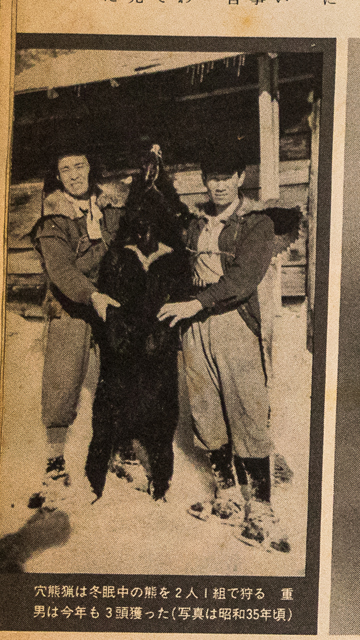
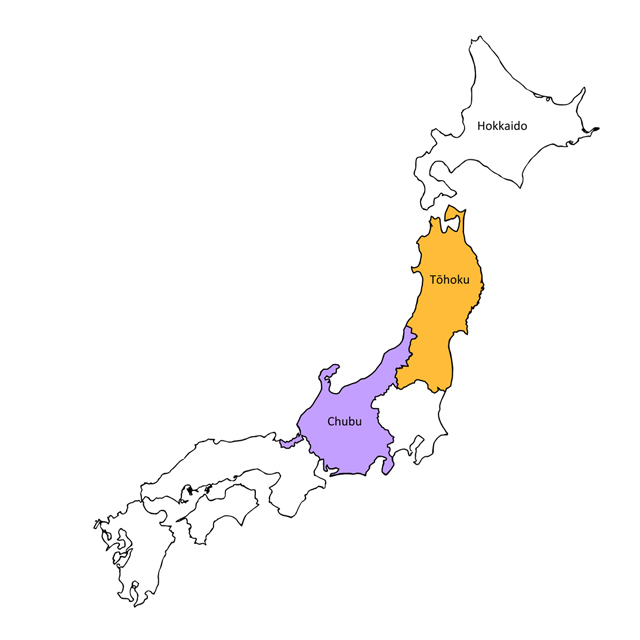
In Japan a “Shoku-nin” is a person who has complete mastery over their profession. While “ryoshi” referred generally to professional sea-fishermen; the professional fly fishers of mountain streams would have “shoku” added as a way of flagging up their unusual skillset and mountain-survivalist lifestyle. Shokuryoshi, then, were the original tenkara anglers.
The Shokuryoshi skillset probably came from the Matagi originally. In fact, the bear-hunting Matagi would often catch iwana (white-spotted char) and move them into headwater streams where “fish-stopping waterfalls” or “uodome” had prevented fish from naturally colonising. That way, they had a permanent emergency supply of protein if a hunt went badly and they were cut off without other supplies. That’s a hell of an insurance policy;and it shows how fishing and survival skills could be transferred between the specialist clans of mountain professionals.
Now here’s the puzzle, the Matagi culture and language comes from the Ainu indigenous people…and as far as I can tell, there are no words for flying insects in the Ainu language that sound like “tenkara”. But as you’ll see below, at some point along the way, the Matagi definitely picked up the term when talking about fly fishing…
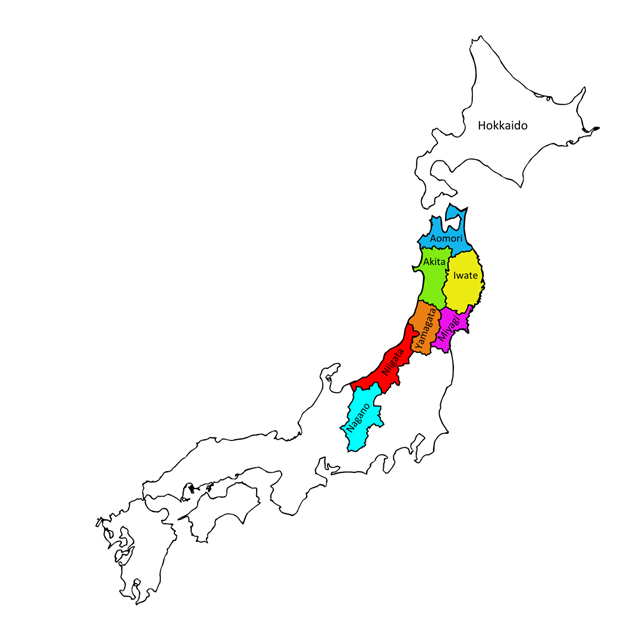
This map shows the north to south spread of the Matagi through Japan – originating in Hokkaido, through Aomori, Akita, Iwate, Yamagata, Niigata and Nagano. All except the last two are within the Tōhoku region (you know – that region where folks heard Kijishi calling fly fishing “tenkara-tsuri”…).
It is on the border between Niigata and Nagano that the Yamada family have lived for generations (below is footage of Shigeo Yamada in the 1970s fishing to supply the mountain settlement of Akiyamago):
Sandwiched directly between those last two prefectures (Niigata and Nagano), lies Mount Naeba. On its slopes you will find the collection of about a dozen hamlets collectively known as “Akiyamago” (home of quite a famous fly pattern).
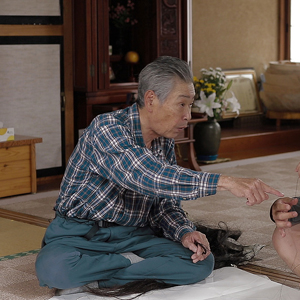
Now, Shigeo Yamada's son Kazuyuki Yamada (pictured here when we visited him in 2017) runs the same guesthouse that his father owned - and he has taken over the professional tenkara duties. He told us that he remembers older generations talking about how the visiting Matagi used the word "Tenkara" to describe the style of fishing they taught the Akiyamago locals...
#micdrop
At Yamada-san’s best guess, the original Matagi that migrated down from Akita directly taught the method of tenkara to the local people in Akiyamago – possibly as long as three or four hundred years ago (judging by what he knew from his family history). This was said to be in return for the nomadic hunters being offered accommodation by local people in Akiyamago (and other similar settlements that they would make their temporary homes). I'd like to research exactly how far back (and where) the evidence that those words for flying insects and applying that to “fly fishing” originated. But that is just an extension of the basic story and it’s quite possible that no more concrete information is known.
But the fact that you or I have even heard the word “tenkara” is also very much down to Mr. Yuzo Sebata…How can that be?
The Sebata-san revelation
Early on in the transition of tenkara from a highly-skilled “bushcraft” survival profession to a sport, a large volume of the writing that fuelled that sport was published by Yamamoto Soseki (sometimes called the father of modern tenkara). Interestingly, although a keen angler and with the means to publish books, Yamamoto-san was mainly acting as a mouthpiece for the skills and knowledge of his friend Dr Sugimoto. The birth of tenkara as a pastime can be said to begin somewhere around the 1960’s and 70’s – gathering pace from the 1980’s onwards. The writings of Yamamoto Soseki were vital to this.
It was also in the 1980’s that Yuzo Sebata basically invented the high-risk, insanely adventurous “genryu” exploration –combined with tenkara fishing. Taking inspiration from the Matagi and Shokuryoshi (Sebata san knew Yamada-san’s father – Shigeo Yamada – it turns out! Shigeo is pictured on the right of the bear in the photo of Matagi above…), Sebata san would climb, swim (as you can see from Minamiya-san’s photo below), forage off the land and even camp within old Matagi caves and shelters for weeks at a time in order to access the most remote and pristine headwater mountain stream areas.
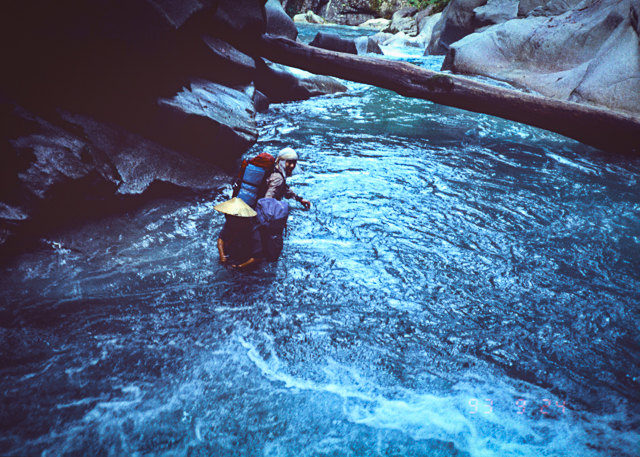
Those headwater streams are called “genryu”.
Tales of his adventures were popular in the angling magazines of the time – and because of this Sebata san found himself helping the editor of “Tsuribito” (Fisherman) magazine to settle a debate. Articles describing the reel-less form of fly fishing that Yamamoto Soseki began promoting would sometimes call it “fly fishing” (kebari-tsuri) and sometimes tenkara or tenkara-tsuri. Although perfectly natural from the perspective of it being fishing with “kebari” (Japanese for “artificial flies”) this often confused readers – who were also being exposed to regular rod & reel/western “fly fishing” too.
Due to his well-known status (and probably in no small part to his strong, charismatic personality), Sebata-san was asked his advice. His answer was that the reel-less techniques that derived from the Shokuryoshi tradition should be called tenkara – and rod & reel should be called fly fishing.
And so it was from then on!
The First Generation after Soseki
The first wave of prominent tenkara anglers that took up the baton and drove the sport forward included people such as Dr Ishigaki (who was commissioned to present a documentary TV series on a range of masters in the 1980s). That TV presenter role along with books and articles established Ishigaki-sensei as a prominent authority – eventually taking on a kind of unofficial tenkara ambassador role. The title “sensei” is naturally added because he is a University professor, based at Aichi Institute of Technology (not some BS attempt to “Japanify” the whole thing and shroud it in voodoo – OK?).
Several other tenkara figures appeared in the Japanese fishing media of the time (often starring with Dr Ishigaki in the TV series videos called “Weekly Sunday Fishing”). Immense thanks to David Walker for his research on this and more info found by David can be seen here: https://discourse.10colorstenkara.com/t/dr-ishigakis-weekly-sunday-fishing-video-series/32).
These figures included people like Hiromichi Fuji, Masami Sakakibara, Sebata-san, Keiyū Takekabu and Katsutoshi Amano. Naturally, over time, the experiences and preferences of all these practitioners developed in slightly different directions. As each oftheir characteristic styles of tenkara evolved, they began to form slightly different “camps” of tenkara.
For instance, Masami Sakakibara embraced the use and development of level lines – whereas Hiromichi Fuji only recognises furled lines as true tenkara. If you need to brush up on all the different tenkara lines, You can get a complete lowdown here: https://www.discovertenkara.com/ultimate_guide_to_tenkara_lines/.
This development of different “solar systems” around specific figures in the tenkaraverse (!) is of course incredibly complex and probably impossible to fully describe. Instead, it is enough to know that (as with any activity that people are passionate about) there are somedifferent schools…BUT, all schools in Japan have a very clearly traced relationship to what those good ol’ Shokuryoshi boys did to obtain food for their families. It is very far from “just make any old thing up and you can call it tenkara”…
Within this generation – there was a small vanguard of ultra-gifted anglers who developed into technically brilliant practitioners. Nicknamed the “Tenkara Acrobats” – three of their prominent members were Yoshiyuki Mushu, Kazuo Fujiwara and Masami Sakakibara. Each one of them had special, next-level, skills that set them apart. While Sakakibara-san (Tenkara-no-Oni) is now distanced from that group, Fujiwara-san and Mushu-san will still see each other and compare notes at various events.

Changing direction again, you have the folks who follow a similar path to Sebata-san’s genryu exploration – such as Keiichi Okushi, Keiichi Ito, Jun Maeda and more. You can learn more about the 3 main river “types” (Honryu, keiryu and genryu) that are targeted for fly fishing and tenkara here: https://www.discovertenkara.com/whats-the-link-between-organised-violence-and-japa/.
Just know that a true “genryu” stream is one that can only be accessed by hard hiking – and is far from the nearest road.
For genryu addicts the fishing is really only a small part of the whole experience. The ability to hike, rock-climb, rough-camp, swim with a full pack, cross white water using rope-techniques and survive off the land make up, when combined together, 90% of the experience. In fact, by taking on all those other skills and hardship – you “win” the privilegeof casting your fly to unpressured fish.
In this way, the fish are a little bit less picky about what exact fishing technique you use – but you must have excellent survival skills and knowledge and be willing to sweat bullets to earn the right to cast your fly to them. Keiichi Okushi describes specific genryu trips on Adam Trahan’s tenkara-fisher site – and he has been kind enough to write a series on the philosophy and culture of genryu fishing here too: https://www.discovertenkara.com/keiichigenryuaddict/
The Second Generation
Now we are just coming into the time when talented anglers have studied with one or several of the very talented figures in the first “post Soseki” generation. Obviously, the boundaries cannot be perfectly neat – but the skill level and depth of knowledge seen in anglers such as Kazumi Saigo andKazunari Kimura are astonishing. There will be many more brilliant anglers out there, under the radar with amazing skills to share if we are lucky enough to discover them. Of course, through Tenkara in Focus, you’ve already hadthe chance to see the technical and deeply thoughtful approaches of Kazuo Kurahashi and Go Ishii to name just two.
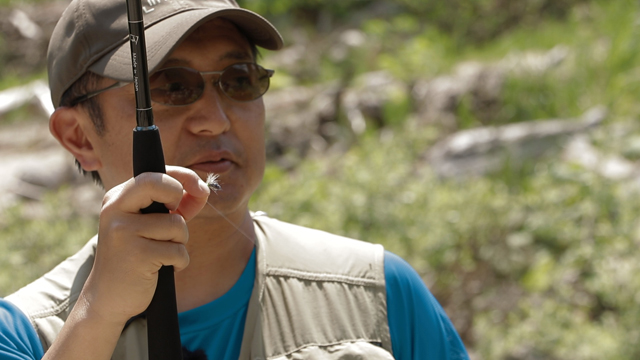
At the same time, there are also still master tenkara anglers who have lived the life of a professional Shokuryoshi. They haven’t all died out as is often reported… Some still do it today for at least part of their living – which is simply amazing. And you only need to look at Hirata-san’s knowledge for how to increase hook-up percentage on downstream presentations (by controlling the angle of his horsehair casting line) to realise how valuable that genuine Professional knowledge is too.
Watch this space for Hirata-san’s masterclass in Season 2 of Tenkara in Focus where he teaches that secret and many more…
Out of Japan: A new Galaxy in the Tenkaraverse
In 2009, Daniel Galhardo pulled off something remarkable. His company (Tenkara USA) was the first to successfully manufacture and distribute Tenkara rods and information outside Japan at a large scale. In parallel (initially accompanying Daniel on research in Japan) Chris Stewart set up TenkaraBum as a means of distributing established, Japanese-made tenkara rods in the West. The genie was now out of the bottle and on the loose in the USA and beyond. More companies have followed, and the world gained a western tenkara industry that has fuelled a spike in interest within Japan. A nice boomerang effect.
The rapid expansion beyond tenkara’s birthplace was aided by the important support and guidance of Dr. Hisao Ishigaki. As he explains in Episode 1, Season 1 of Tenkara in Focus, Dr Ishigaki is on a mission to convert people to the enjoyment of tenkara (especially from other forms of fishing in Japan). By becoming Daniel Galhardo’s “tenkara father”, the collaboration allowed a message of tenkara’s “low barrier” to participation and a minimalist “one fly” philosophy to be quickly spread.
This removal of perceived barriers is perfect for encouraging newcomers. It is an excellent match for a company bringing an old – but scarily unfamiliar – concept to a sceptical fly fishing audience. It is also the best way to encourage a non-fishing audience to try it out…The “Ishigaki camp” of tenkara makes a very successful meme (the idea is easily passed on).
Thanks to that rapid globalisation and an awakening of curiosity, there is now a need for sites like ours to share ideas about the next steps beyond your first “conversion” experience of tenkara. Being able to fill in some of the blank areas of the “tenkara map”surrounding the best known strand of “Ishigaki/Galhardo” tenkara is where we get our kicks (and I’ve made a start with the content on this page). I hope that it enriches your own experience and opportunities on stream and at the fly tying vice too.
To give you some clues on what to get your teeth into, let’s talk about tenkara rods (and what you need to know about them).
Tenkara rods
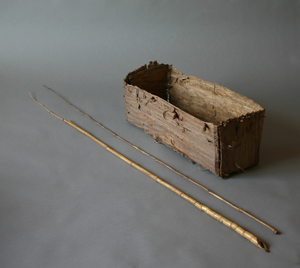
In the beginning – and so for the vast majority of tenkara’s history – a tenkara rod would be a single stave of bamboo. The hollow stems, powerful cellulose fibres and natural taper make amazing raw material for fishing rods of all kinds. Of course, multiple species of bamboo grow everywhere in the Japanese mountain areas. You’d have to be an idiot to not work out its potential. N.B. Don’t even consider buying one without checking out our Tenkara Rod Guide.
We’re lucky to have a fantastic picture of a historic rod – owned by Shinaemon Toyama (see second paragraph down below second set of flies here: http://www.hi-ho.ne.jp/amago/b-streams/flytying/tenkara.html); a shokuryoshi and mountain guide to British Diplomat Ernest Satow who described tenkara-style fishing in his diaries of the 1800s in Japan.
In the DVD Volume 3 of “Discovering Tenkara”, Shōichi Saitō describes how shokuryoshi in his village would climb over the mountains into the next valley carrying one-piece bamboo rods and baskets of fish, bringing them back to hang to dry from a bamboo rack as food for the villagers.
In the same way, Yamada-san in Akiyamago showed us his father’s and his uncle’s bamboo rods. These were definitely “tools of the trade” for hardened shokuryoshi. An interesting element was their use of a separate, quite heavy wooden handle (about three feet long) that they used to counterbalance the long, strong bamboo rods (that were otherwise a single piece). Those handles were made so that any of the single-piece rods that his father hid in various places long the trails to his fishing spots would fit into that one handle. That
way, he always had a spare rod nearby in case of breakage.
Those long, strong (and quite stiff) rods were used to quickly drag a fish to shore to be dispatched, gutted, wrapped in bamboo leaves and placed in a creel. A common preservation method, which Yamada-san’s family also used, is “Yaki garashi” – where fish are dried on skewers set back from the main heat of a charcoal fire. This doesn’t cook or smoke the fish, but making them bone dry stopped them going mouldy and spoiling throughout a long mountain winter.
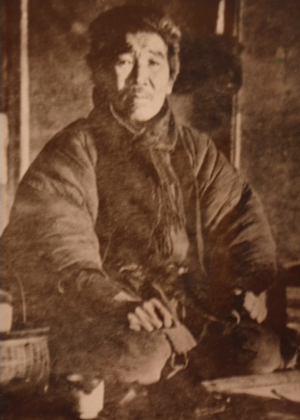
More modern professional Shokuryoshi and their descendants who catch fish for food still prefer very long, strong and stiff rods for their tenkara for the same reason of fast, no- nonsense beaching of fish to eat. They also work well with a wetted, six-strand horse-hair line which has plenty of casting weight. Gamakatsu are quite famous for their ability to produce rods of this kind – and that quality comes at an appropriately high price (in the $500 to $600 ballpark).
Modern, graphite rods are now cleverly made to be telescopic (in typically 8 or 9 sections) – and this makes them incredibly portable. This is a very good match for a highly-mobile fly fishing style that might be combined with long hikes and even camping.
Interestingly, the anglers currently at the cutting edge of tenkara as a pastime (and who practice catch and release to protect precious wild fish stocks), have moved very much towards far more flexible rods that are capable of casting very light level lines. The popularity of angling in Japan has made the fishing extremely technically demanding in rivers that are fairly accessible to the public. So, in response, the tactics/preferred tools and materials have evolved to meet that challenge.
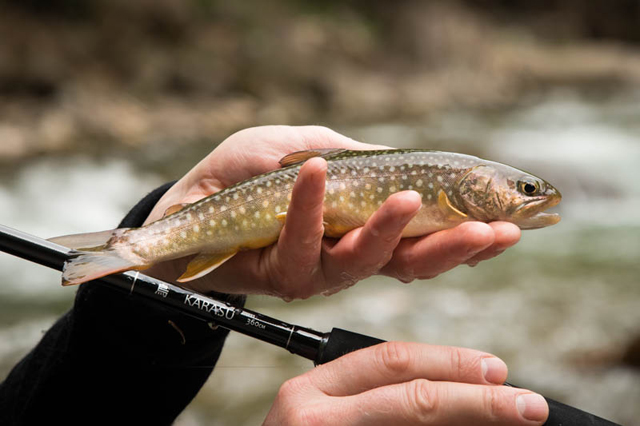
There are only a very small number of places where the exquisite quality Japanese carbon fibre and resin cloth can be expertly formed and “grilled” to produce blanks of the highest quality. Those small number of producers react to the specific demands of the major rod companies in Japan to produce tenkara (and other) rods of unmatched quality and consistency. We are incredibly lucky that our own Karasu tenkara rods are produced as part of the top-end Japanese rod industry.
The important thing to understand is that any one rod model is always a complicated compromise between stiffness, lightness, strength, length, balance and “recovery” (or how easy it is to stop it “wobbling” after finishing your casting stroke). It is incredibly difficult to produce a high-performance casting rod that is:
- Much longer than normal trout fly rods
- Capable of being loaded by MUCH lighter casting lines
- NOT “nose-heavy” – even without a reel attached
Nowadays, as long as you know what you are looking for (and here’s a free guide if not: https://www.discovertenkara.com/blog/blog-19/), it is reasoably difficult to buy a truly terrible tenkara rod. After that, it is a case of matching your preferences to your budget as with anything in life.
Wazao
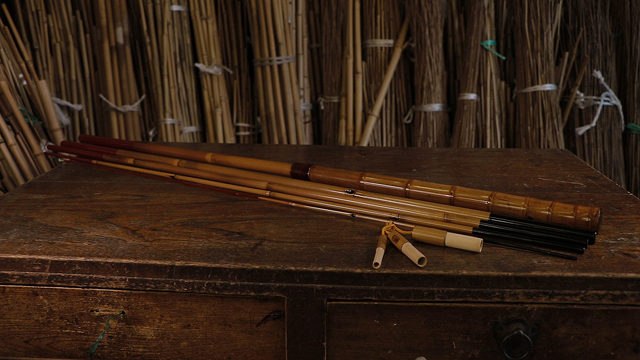
Perhaps the most fascinating modern development in tenkara is the “wazao” (urushi-lacquered whole bamboo) style of rod building…This method is of making rods is very old in Japan. Originally, these exquisite rods would have been far beyond the reach of Shokuryoshi and reserved for the elite members of society. But now, the skilful wazao maker Masayuki Yamano (Yamano-san) has become interested in tenkara as well as the wide range of other fishing methods that his rods are used for.
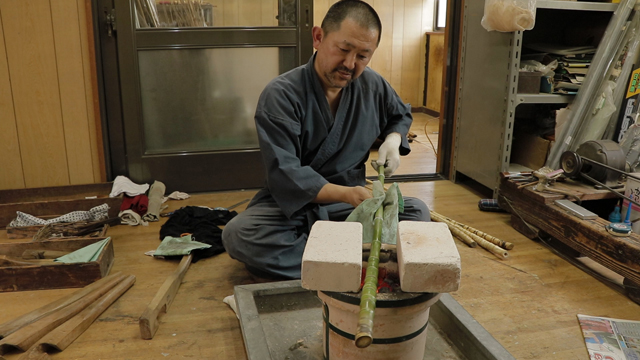
By understanding tenkara techniques, he has been able to produce absolutely beautiful wazao rods with the right characteristics for tenkara fishing. This modern application of a very old tradition is a fantastic way of keeping both fly fishing and craftsmanship traditions alive and relevant.
Tenkara nets
There is a Japanese style of net (often with a hoop set at an angle to the handle) that is now associated with tenkara. These nets are called “tamo” and are actually not a traditional aspect of tenkara. Instead they are something that has been imported in recent times from a very prestigious style of keiryu fishing for a species known as “ayu” (sweetfish, Plecoglossus altivelis). Shokuryoshi, on the other hand would quickly drag a fish ashore and dispatch it without using a tamo…
In ayu fishing, very long (8 to 10 metre long) rods are used along with a live ayu and trailing treble hook rigs. The live fish triggers the territorial response of an ayu in the river, which is then “foul hooked” on the trailing treble hooks. Both fish are then swung into the net or “tamo” that is held on the belt of the angler. The angle of the net hoop helps it to act like a basket, ready to receive the fish even if you don’t have time to pull the net out of your belt and hold it out to catch the fish.
Ayu fishing in this way is quite polarizing – with avid fans and people who dislike it to an equal degree. But, the tamo is certainly a great tool that can also be very helpful for good catch and release tenkara fishing.
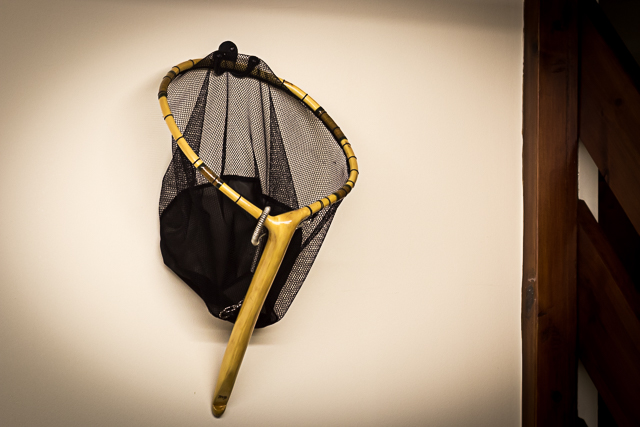
Traditional tamo are made by selecting a perfect branch of a suitably flexible species of tree (often pine species in Japan, even though “tamo” is a species of Japanese ash tree). The branch needs to have a thicker main stem that acts as a handle – and two side-branches that emerge directly opposite each other from that central stem. Cutting out and smoothing down that central stem allows the side branches to be bent and steamed into a hoop shape before being set aside to season. Seasoning prevents the wood from splitting later in the process. Splicing the two ends of the hoop arms together completes the shape of the tamo frame and makes it ready for finishing and decoration. Traditionally tamo are finished with many layers of urushi lacquer. Sometimes shaved fragments of mother of pearl from sea shells are inlaid into the layers of lacquer to create a glitter effect and a variety of bindings and whippings may be used to augment the natural beauty of the wood. The mesh is lashed to the hoop of the frame using neat cord wraps – avoiding the need to thread a seam of mesh onto the frame itself.
Stag horn is commonly included in the handle of a tamo – this is because deer are strong swimmers and it is a good luck charm for staying safe while wading in powerful Japanese rivers.
Tenkara flies
In Japanese “ke” means fur or feather. Hari means needle or, with a slight tweak to the kanji character, it also means fish-hook (which were made from bent sewing needles in the past). When words that start with “h” sounds are joined onto the end of another word; it is easier to say “b” than “h”. For that reason, “hari” becomes “bari” in the word “kebari”. You can also get a top to toe guide to tenkara flies here But here’s a quick intro to get you going…
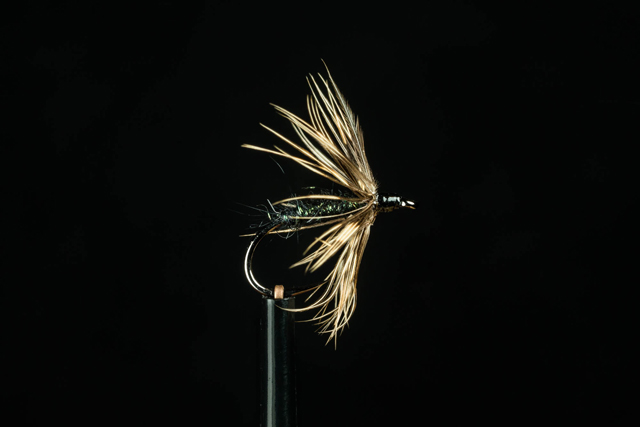
A clunky literal translation of kebari then is “feathered hook” – but of course, its real meaning is “fishing fly”.
There is a huge range of kebari patterns in Japan – though the vast majority of them are designed as wet flies (in other words, NOT fished as “dry” flies floating on the water). Instead the angler controls the depth of the fly by the angle and position of the rod tip and line once the cast has been made. In this way, even stiff-hackled wet flies can be fished on, in or under the surface depending on what you do with your casting line.
Despite the striking appearance of the Japanese reverse hackled flies (sakasa kebari – where “sakasa” means “reverse”), these iconic flies were found to make up only about a quarter of all tenkara patterns in a survey done by kebari researcher and artist Yoshikazu Fujioka.
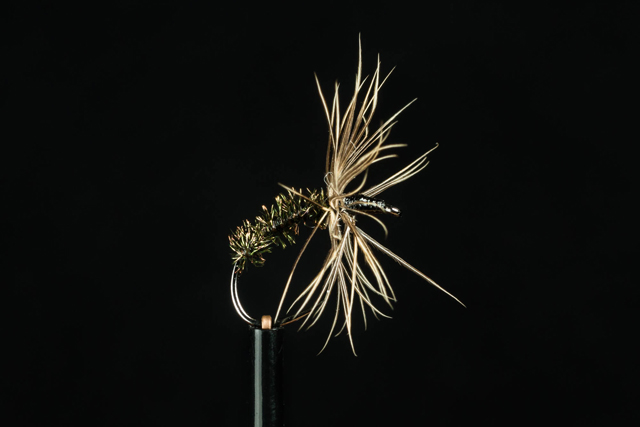
It is also not the case that each village or area had only one particular fly pattern that all the anglers of the region would use. Sometimes you can spot strong similarities (or even identifiable patterns) that have been passed down from teacher to pupil – but there is always a big range of local variation. Fujioka-san’s wonderful collection of kebari examples are catalogued according to the location that he found each example. This gives a great chance to match the design of a fly to the conditions of the rivers where they were fished. It’s important to realise though that Fujioka san is not saying that “this fly is the only one that anyone uses in this village”. Instead it is more like “Here is an example of a fly. I found it in this part of Japan”.
Not only that, but it is very unusual to find tenkara anglers in Japan who just tie and fish one fly pattern. There are a few examples of that though – and it is a great illustration of how important all your other fishing skills can be when it comes to any kind of fly fishing. It was probably most common among historic Shokuryoshi who were fishing in relatively unpressured rivers (where catching and killing hundreds of iwana in a day was very common). Once an effective method was found that suited the conditions of the river and the preferences of the fish, a fly that would function well for that method could be settled on.
At the stage when a fly pattern looks enough like “food” to a fish, tenkara anglers (old and modern) focus much more on how the materials of that fly helped the angler to make it function properly.
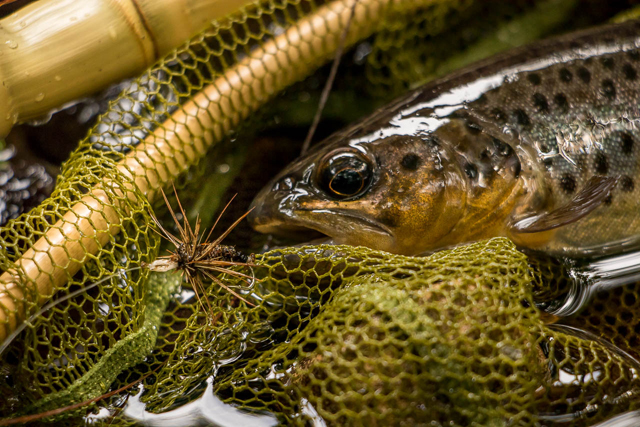
A brilliant example of this is Yamada-san who, when we asked why he used peacock herl for the body of his flies replied “Because it soaks up water nicely and that makes it easier to turn over and cast further”. Another great example is Masami Sakakibara tying rooster hackles with the pale underside facing towards the eye of the hook. That way, when the tippet is under light tension and the fly has sunk, the pale side of the feather is facing towards the anglers and is nicely visible. When that pale disk vanishes, you can set the hook!
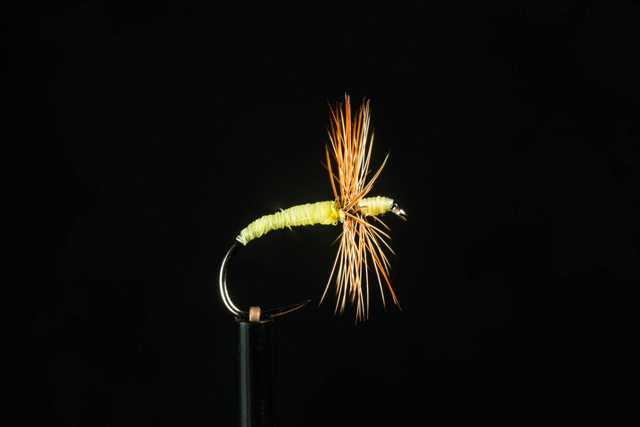
Using the pale underside of that hackle as a “bite indicator” instead of an imitation of a particular fly species is a perfect description of the difference in tenkara fly design from “close copy” western fly tying approaches.
I think this “functional” way of designing kebari – and how those designs match perfectly with different presentations – that is a massive part of the enjoyment of tenkara for me. It’s also a great reason to introduce those presentation methods…
Tenkara Fishing
The way each presentation method can be chosen to match conditions – and how to then match the design of your fly to that method – took me an entire book to explain clearly. BUT, a very quick introduction to some core tenkara presentations will definitely help you to get the feel of things. You can also find out a ton more in our free email lessons: You can Click Here to Subscribe.
First of all – do not neglect the good old “fly first” cast (where only the fly lands on the water) and a three to six second dead drift. It is an incredibly successful tactic – especially when you know how to keep moving and covering new water all the time. You can also get some vital tricks of the trade on this webpage too: https://www.discovertenkara.com/how-to-become-an-expert-in-japanese-tenkara-tactics-part-one/.
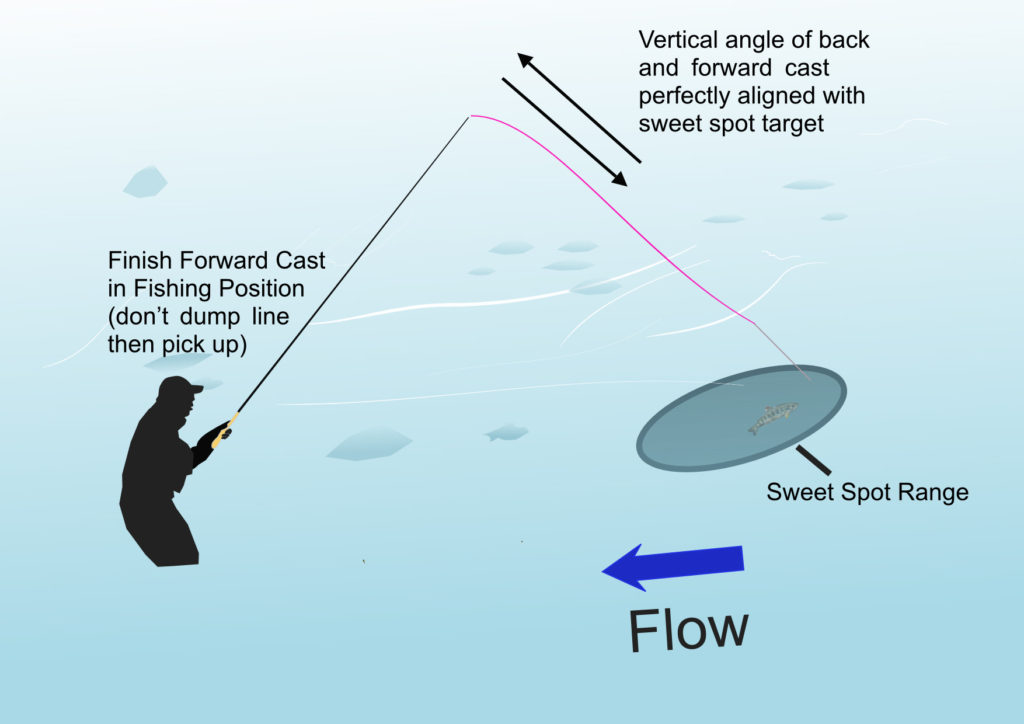
Anchoring or “tome-zuri” – this is where stiff hackled kebari really shine. You can use them like mini grappling hooks to lock into any small currents that are flowing away from you. That way, you can hold the fly static and vulnerable until a fish gives in and says “oh well, I might as well eat it”.
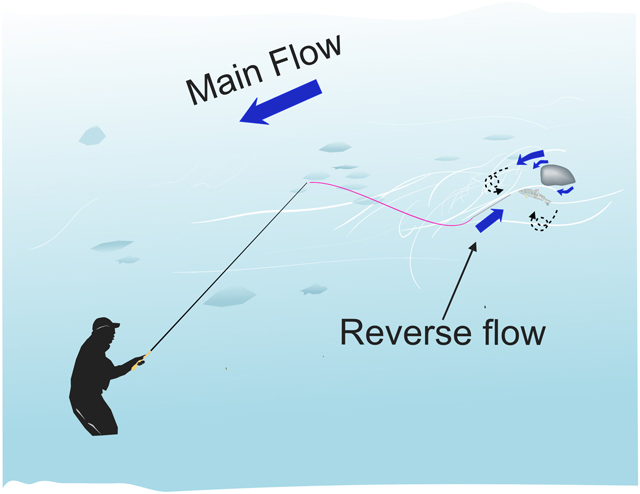
Slotting – I don’t know if this has a proper name in Japanese, but it is used A LOT. In the powerful rivers of Japan, large areas of the stream are too fast to get an effective dead drift. This is a shame, because there are often slow patches of water near the riverbed below those fast surface currents. That is where fish can sit and wait for the current to bring them food. One solution is to go down the route of competition anglers and use weighted flies to punch through the fast surface currents. Another option is fishing downstream and just slowing your fly down below the pace of the true dead drift. This can be an incredibly tactic on the right day…
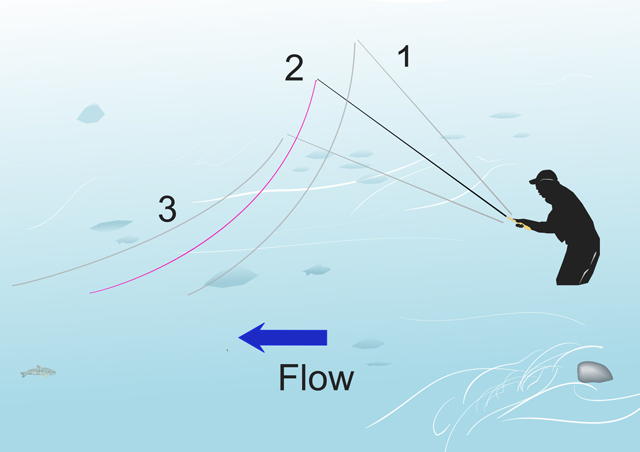
Yokobiki (sideways pull). This one is great for trout and char; often lousy for European grayling…but you can start to see why those soft, mobile-hackled patterns might come into their own!
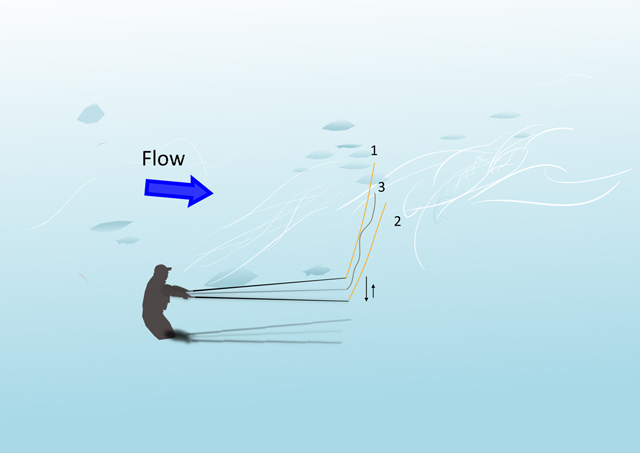
You can find a lot more information on presentation tactics (how to choose them and match them to specific flies) in the book “How to Fool Fish with Simple Flies” and our “Manipulations Volume 1 online course”.
So, along with all our other written and video content on this site and available in our full range of information products, I hope that this overview page has given you food for thought. If you learned anything at all from it, then please do use your favoured social media to pass it on so your friends can benefit too.
Paul
